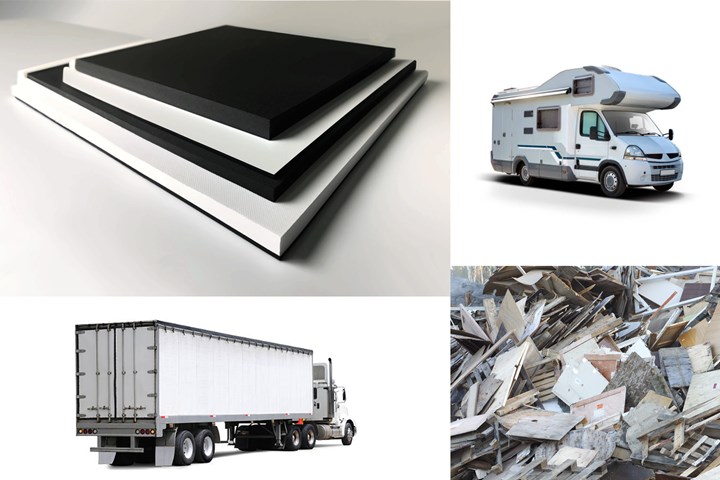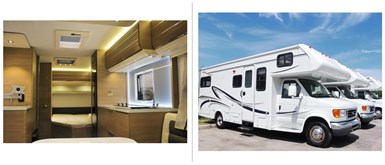A new generation of PP foam core for lightweight truck trailers, RVs
Extruded PP (XPP) foam core offers lightweight, high-performance monomaterial panels that are easily recycled for truck flooring, sidewalls or cabinet/furnitureboards as the transportation industry seeks a replacement for plywood.

Hardex XPP foam core offers lightweight, recyclable composite panels as replacement for plywood. Photo Credit: (top left) Spur (top right, bottom images) Getty Images
Multiple companies worldwide have developed new grades of polypropylene (PP) foam aiming for higher properties and lower weight, mostly for injection molding interior parts for the automotive industry (see recent market report). Toray Industries (Tokyo, Japan) has also developed a new cross-linked PP foam core for helmet and cushioning applications. But what Spur (Zlín, Czech Republic) is offering is much different, targeting sandwich structures using fiber-reinforced composite skins — a market considered by most large plastics companies as ancillary or niche.
“We too are a plastics manufacturer,” says David Pospisil, business manager for Spur, “but we saw a need developing 5-6 years ago for lightweight, high-performance panels that can be easily recycled. So, we started developing what is now our Hardex XPP (Extruded PP) closed-cell foam core.”
Spur shreds Hardex PP foam-cored sandwich panels and regranulates that material for extrusion into profiles for kitchen cabinets and furniture. Photo Credit: Spur
Is it indeed easily recycled? “We have been producing XPP foam for lamination with PP skins in full PP lightweight panels used by Better Shelter for refugee housing,” says Pospisil. “And the waste from this production we are upcycling into other products in our factory, such as kitchen profiles and edge bands for furniture. But we can definitely recycle the whole panel, even with skins using fiber reinforcement, back into an extrusion-grade material, which we are doing in-house.” To learn more, watch the Spur webinar hosted by CompositesWorld on May 24, 2023, “Thermoplastic Foam Cores for Composites: Light, Productive, Recyclable XPP.”
Large market in trucks and automotive
Pospisil says there is a lot of demand for lightweight materials in trucks and trailers. “We have done a lot of testing with our materials in floors and sidewalls of truck trailers,” he explains, “and we have a number of products in development. More broadly, there is a huge demand in the automotive market to replace PVC [polyvinylchloride] and PET [polyethylene terephthalate] foam with PP foam in order to achieve monomaterial parts that are easier to recycle. Previously, these types of parts used several different types of materials usually glued together, so that separating was required and a bit difficult, making recycling more challenging and expensive. With our material, you can produce a PP sandwich panel with PP skins and Hardex XPP foam core, fused together with thermal bonding. When you’re done, you can shred that panel and regranulate it into a material for extrusion. This is what we are doing now, so it’s proven technology.”
“By replacing plywood with Hardex XPP foam in these flooring panels, it is possible to drop 300-400 kilograms per truck trailer.”
This approach is what Spur is pursuing in truck trailers, where Hardex XPP is the foam core and the skins are typically glass fiber-reinforced PP. “If our customers use a heated double belt press with cooling to join the skins to the core, they can produce these panels at a rate of 4 meters/minute. Currently, production of truck panels is very slow, where FRP [fiber-reinforced polymer] skins are glued and vacuum-formed with foam and other cores, often taking hours for the adhesives to cure. With our materials, you replace that system with thermal lamination. We are merely making the foam. But this is a big opportunity for our customers, who are fabricating panels and parts that are offering new solutions for the transportation industry.”
Hardex XPP foam core offers lightweight panels for truck trailer flooring and sidewalls, which can then be recycled into truck skirts and fairings. Photo Credit: Getty Images
Can foam core really stand up to the in-service abuse seen by truck trailer floors? “So far, we are confident that these panels will be able to resist the loads seen in truck floors and sidewalls, but this is what we are working through as part of various development projects,” says Pospisil. “If more resistance is needed, then panel manufacturers can apply another ply of glass/PP tape, for example, or reinforce localized areas.”
He notes the goal is to replace plywood, which has become much harder to obtain, more expensive and is also heavy. “By replacing plywood with Hardex XPP foam in these flooring panels, it is possible to drop 300-400 kilograms per truck trailer,” says Pospisil. “And, at the end of life for these panels, it’s then possible to shred them, regranulate and extrude the recycled material as side fairings or truck skirts. So, this is a real opportunity to establish a circular product and process chain for these transportation companies.”
Another large market for lightweight, recyclable panels is RVs, where Hardex XPP foam cored-panels can be recycled and reused as edge trim. Photo Credit: Getty Images
He notes another large opportunity is in recreational vehicles (RVs). “We are again looking at sidewalls but also furniture,” says Pospisil. “We are offering significantly lower-weight in a foam-cored panel that has no moisture absorption and can be recycled back into bandings that are already used in RV interior trims and cabinetry. We think this lighter weight construction for furniture will also be attractive for builders of boats, yachts and other marine vessels.”
Not your traditional extruded PP
There are multiple types of PP foam including: expanded PP (EPP), cross-linked PP and extruded PP foam, also abbreviated as XPP. “EPP is a lower modulus particle foam that you will see used in better quality cycling helmet, for example,” says Pospisil. “Our material is XPP but it is extruded foam, not cross-linked. However, our product is much different than EPP and crosslinked PP because we have developed a special grade of polymeric foamthat gives both high mechanical properties and recyclability. We have also developed a unique know-how to get even higher performance than is standard since XPP began widespread development in 2017-18.”
Pospisil says Spur started looking at this new development in XPP foam in 2016 to replace wood in pallets. “But then COVID hit, and we pivoted to producing masks and personal protection equipment. We got back on track with our XPP development in 2021 and by 2022 had samples to show to the automotive industry. We then scaled our production and are now finalizing our machine to make standard size foam boards [2440 x 1220 millimeters, 5-100 mm thick] per our customers’ requirements. In June, we will begin producing these Hardex XPP foam boards in high volume to fulfill serial production orders placed last year. We think now is a good time to work with CompositesWorld and let the composites industry know that we are ready to grow our applications and offer new opportunities for fabricators and OEMs to achieve lightweight and sustainability.”
Related Content
TU Munich develops cuboidal conformable tanks using carbon fiber composites for increased hydrogen storage
Flat tank enabling standard platform for BEV and FCEV uses thermoplastic and thermoset composites, overwrapped skeleton design in pursuit of 25% more H2 storage.
Read MorePEEK vs. PEKK vs. PAEK and continuous compression molding
Suppliers of thermoplastics and carbon fiber chime in regarding PEEK vs. PEKK, and now PAEK, as well as in-situ consolidation — the supply chain for thermoplastic tape composites continues to evolve.
Read MoreCombining multifunctional thermoplastic composites, additive manufacturing for next-gen airframe structures
The DOMMINIO project combines AFP with 3D printed gyroid cores, embedded SHM sensors and smart materials for induction-driven disassembly of parts at end of life.
Read MoreNatural fiber composites: Growing to fit sustainability needs
Led by global and industry-wide sustainability goals, commercial interest in flax and hemp fiber-reinforced composites grows into higher-performance, higher-volume applications.
Read MoreRead Next
“Structured air” TPS safeguards composite structures
Powered by an 85% air/15% pure polyimide aerogel, Blueshift’s novel material system protects structures during transient thermal events from -200°C to beyond 2400°C for rockets, battery boxes and more.
Read MoreVIDEO: High-volume processing for fiberglass components
Cannon Ergos, a company specializing in high-ton presses and equipment for composites fabrication and plastics processing, displayed automotive and industrial components at CAMX 2024.
Read MoreDeveloping bonded composite repair for ships, offshore units
Bureau Veritas and industry partners issue guidelines and pave the way for certification via StrengthBond Offshore project.
Read More
























